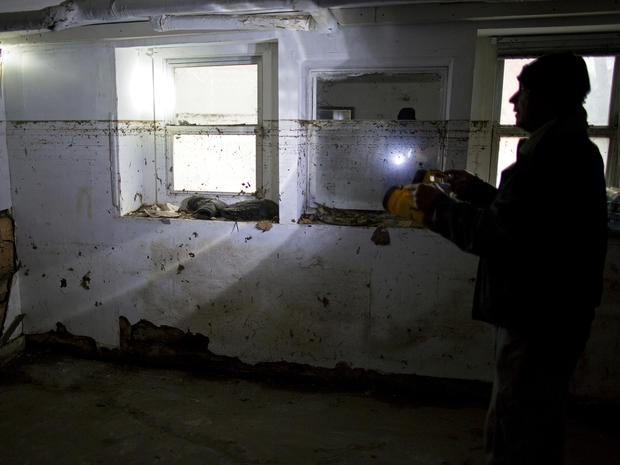Sandy: What help can homeowners get?
With more than 400,000 homes and businesses still without power a week and a half after superstorm Sandy made landfall, the Federal Emergency Management Agency said that more than 100,000 people are eligible for temporary housing at hotels or motels in the New York-New Jersey area. However, it's unclear exactly how many people are taking advantage of that option.
Since the storm hit last week, more than 317,000 people have registered with FEMA for financial help, and the agency has approved more than $300 million in emergency aid.
More than 56,000 people have also been ruled eligible for FEMA's individual and households program, which provides money for renting a new place or for housing repairs.
Individuals and families staying in a shelter who cannot return to their homes due to storm damage may be eligible for the Transitional Sheltering Assistance program if they register with FEMA for assistance, can verify their identity, and their primary residence is in an area designated for the program and occupancy can be verified.
People who sustained losses in designated counties in New York and New Jersey should register with FEMA (800) 621-3362 or visit disasterassistance.gov.
The need is great: On his radio show Friday morning New York City Mayor Michael Bloomberg estimated that 1,000 houses in the city were destroyed during the storm, and up to 80,000 have water damage.
FEMA Administrator Craig Fugate said some people who have been forced out of their homes have sought shelter at hotels as far away as Albany.
FEMA said it is also providing grants for home repairs, low-cost loans to cover uninsured property losses, and other programs to help individuals and business owners recover.
There are 27 shelters in operation housing nearly 5,000 people. On Wednesday, about 200 storm evacuees were moved from shelters reverting to their normal school use and into tents erected by the Red Cross at Monmouth Park Racetrack in Oceanport, N.J.. The tent city had been set up originally to house power crews from other states helping in restoration efforts.
FEMA assistance also may be available to affected homeowners for repairs, for which insurance reimbursement is not attainable.
For homeowners whose property did not suffer damage but who suffered from the storm (for example, from continued power outages), there are fewer options available. One such benefit is a reimbursement for the purchase of a generator, but only if there is an existing medical condition which requires medical equipment.
Assistance may also be available for heating fuels, disaster cleanup-up items (i.e., wet/dry vacuum or dehumidifier), and moving expenses. Food losses are not covered.
The maximum amount of financial assistance a disaster survivor may receive under the Individual Assistance program is $31,900.
FEMA also partners with other agencies (including HUD and the Small Business Administration) to address housing needs. The Treasury Department and IRS are also waiving low-income housing tax credit rules that otherwise prevent owners of low-income housing from renting to disaster survivors who do not qualify as low-income.
- FEMA Disaster Recovery Center locator
- FEMA Housing Portal
- To search for nearest Red Cross shelters text: SHELTER and your zip code to 43362 (4FEMA). For example: Shelter 01234 (Standard rates apply)
- Download FEMA smartphone apps
- Important phone numbers: FEMA: (800) 621-3362; N.Y. Hurricane Sandy Helpline: (888) 769-7243 or (518) 485-1159; N.J. Helpline: Dial 211 or (877) 652-1148
The nor'easter that blew into the New York area Wednesday complicated matters further, knocking out power to thousands (including some who'd just had their power restored after Sandy).
FEMA was forced to temporarily shut down its tent offices where storm victims had been going to for help.
On Staten Island, three FEMA mobile disaster units - where victims could register for disaster relief, and which also served as food distribution and warming centers - were shut.
Public Information Officer John Knowles said the tent facilities had to be shut down for the safety of the disaster survivors and staff. A fixed site at Mt. Manresa Jesuit House was open and fully-operational Wednesday, Knowles said.
FEMA Administrator Fugate also said Thursday that the disaster relief agency has several hundred mobile homes in its inventory of emergency supplies and has started moving some of them to the disaster zone. Forty prefabricated homes were en route from a staging area in Maryland to a staging area in New Jersey, FEMA officials said. State officials in New Jersey and New York will decide where the houses will be placed.
Officials still don't know "what total demand would be," Fugate told reporters.
FEMA was widely criticized for using trailers after Hurricanes Katrina and Rita devastated New Orleans and parts of the Gulf Coast in 2005, after many of those trailers were later found to contain toxic levels of formaldehyde. Fugate said the mobile homes being sent to New York and New Jersey have been approved by the Department of Housing and Urban Development, and are not the same as were those used after Katrina and Rita.
To help victims of Sandy, donations to the American Red Cross can be made by visiting Red Cross disaster relief, or you can text REDCROSS to 90999 to make a $10 donation.

